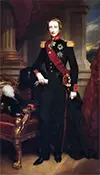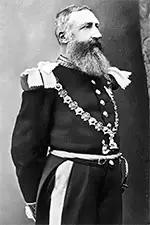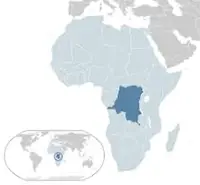King Leopold II of Belgium
Leopold II was King of Belgium for more than four decades, reigning into the 20th Century. 
He was born on April 9, 1835, in Brussels. His father was the reigning monarch, Leopold I, and his mother was Louise of Orléans. Leopold was the second child born to his parents; the first, Louis Philippe, died in infancy, making young Leopold the heir to the throne. The boy grew up as such, living and studying at court. When he was 18, he married Marie Henriette of Austria. They had four children: Louise (1858), Leopold (1859), Stéphanie (1864), and Clémentine (1872). Their hopes of having a son become king disappeared when young Leopold died of pneumonia when he was 10. Leopold I died on Dec. 10, 1865, and his son became King Leopold II. He was 30. During his long reign, he oversaw developments of great change. Work reforms brought about labor unions and measures providing for workplace compensation and laws providing protection against labor exploitation of children. Governmental reforms included a new constitution, in 1893, the advent of universal male suffrage, and a system of voting based on proportional representation. 
The king steadfastly adhered to his father's ideal of geopolitical neutrality. He supplemented that public stance with a strong defense, personified in the building of fortresses at Antwerp, Liége, and Namur. Despite his country's affinity for neighboring France, Leopold refused to get involved in the Franco-Prussian War, in 1870. Leopold II was fond of public works and sponsored the construction of many large buildings and parks, many still standing. Many people referred to him as the "Builder King." He is probably most well-known for the creation and manipulation of the Congo Free State, a large colony in central Africa. Many European powers looked to expand into Africa in the 19th Century. Toward the end of that century, leaders of those powers met at the Berlin Conference, at which Leopold won approval for his plan to pursue a Belgian colony in the Congo. He elicited the assistance of well-known explorer Henry Stanley in this endeavor. 
As it happened, Leopold was the sole owner of the Congo Free State, a huge swath of land in Central Africa that was 76 times as large as Belgium. All of the profits gained by forced labor production of ivory and rubber went into the king's pockets. Members of his personal army, the Force Publique, enforced harsh production quotas; punishments for not meeting those quotas were violence, torture, and death. Because of this and also because of poor working and sanitary conditions that made the spread of illness very easy, the death toll was very, very high. (Conservative estimates place it at more than 1 million.) All of that was in clear violation of the promises that Leopold and other European leaders had made at the Berlin Conference, namely to protect the interests of the people living in newly acquired colonies. It was Leopold himself who organized the International African Association, in 1876, with the aim of pursuing humanitarian projects in Africa. Word spread of the goings-on in the Congo. Under national and international pressure, Leopold ceded control of the Congo Free State to Belgium but only in 1908, and the handover was in the form of a sale, which cost the national government a large sum of money. The Free State then became a true colony, named the Belgian Congo. Leopold died at Laeken on Dec. 17, 1909. His reign of 44 years is the longest in the short history of the country. He had three surviving daughters, but the crown passed to his nephew Albert, whose father was Leopold's brother Philippe. |
|
Social Studies for Kids
copyright 2002–2024
David White




